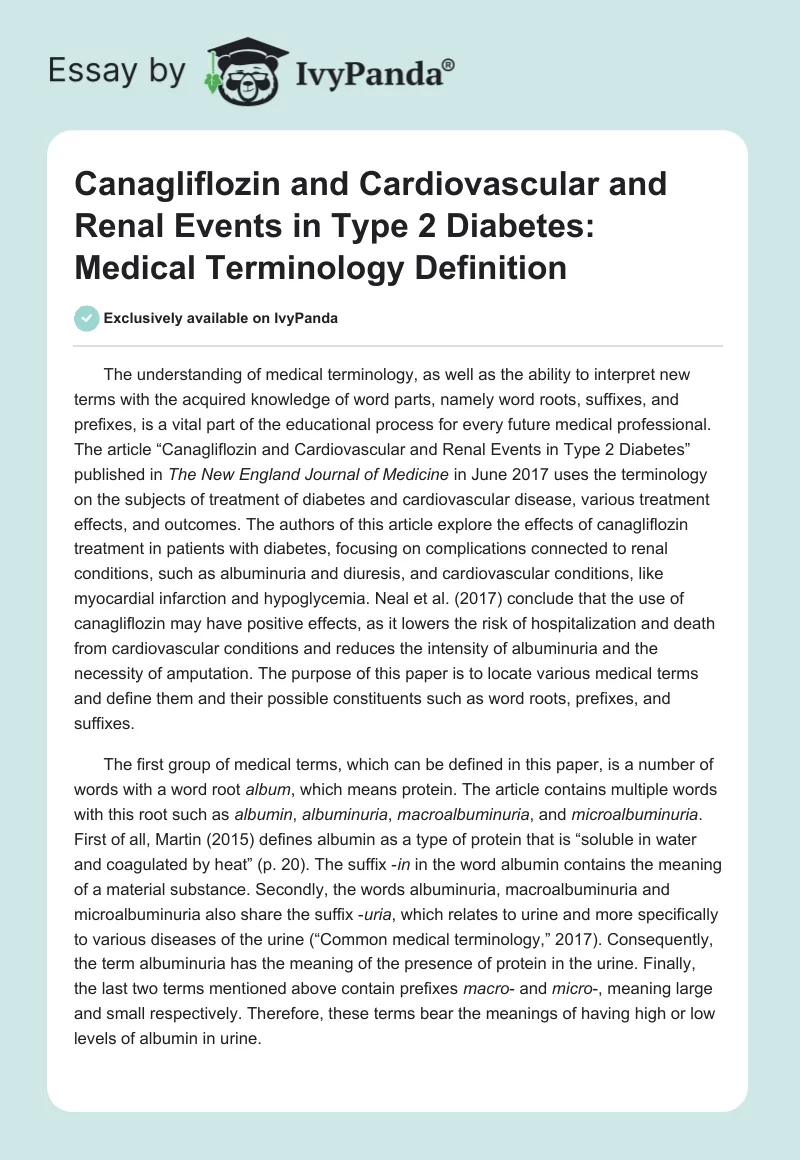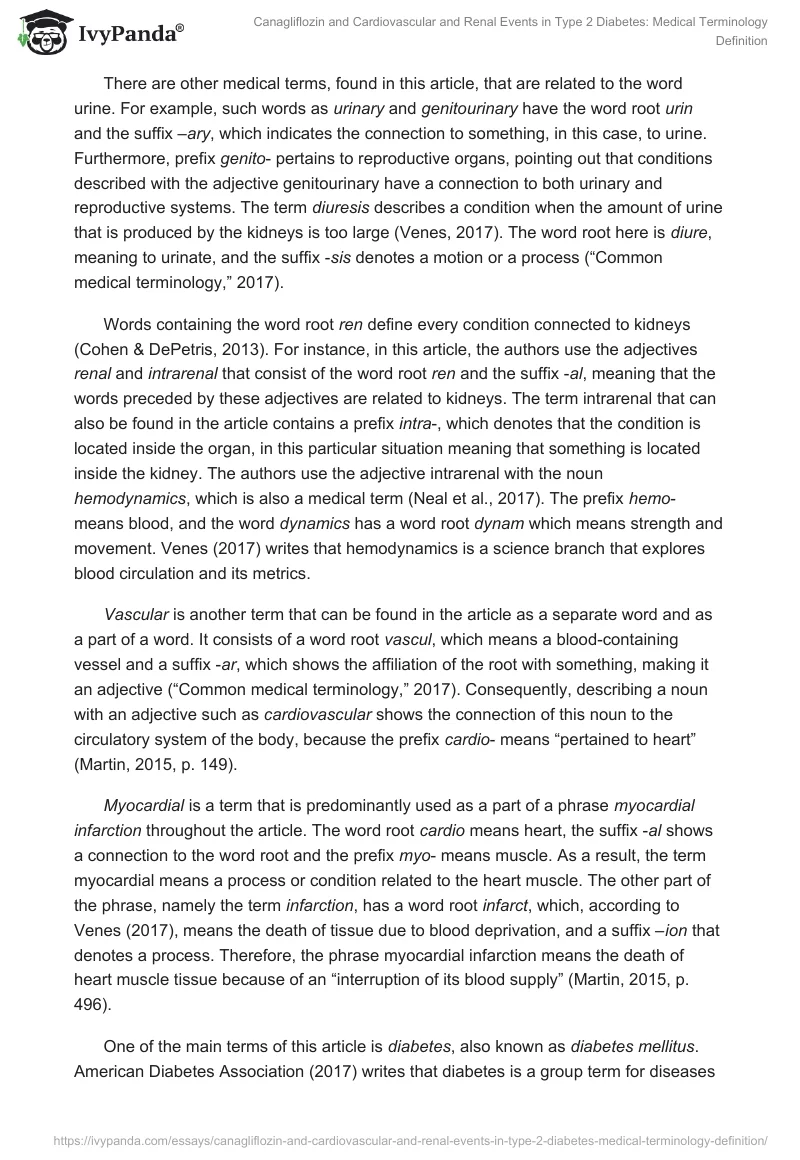The understanding of medical terminology, as well as the ability to interpret new terms with the acquired knowledge of word parts, namely word roots, suffixes, and prefixes, is a vital part of the educational process for every future medical professional. The article “Canagliflozin and Cardiovascular and Renal Events in Type 2 Diabetes” published in The New England Journal of Medicine in June 2017 uses the terminology on the subjects of treatment of diabetes and cardiovascular disease, various treatment effects, and outcomes. The authors of this article explore the effects of canagliflozin treatment in patients with diabetes, focusing on complications connected to renal conditions, such as albuminuria and diuresis, and cardiovascular conditions, like myocardial infarction and hypoglycemia. Neal et al. (2017) conclude that the use of canagliflozin may have positive effects, as it lowers the risk of hospitalization and death from cardiovascular conditions and reduces the intensity of albuminuria and the necessity of amputation. The purpose of this paper is to locate various medical terms and define them and their possible constituents such as word roots, prefixes, and suffixes.
The first group of medical terms, which can be defined in this paper, is a number of words with a word root album, which means protein. The article contains multiple words with this root such as albumin, albuminuria, macroalbuminuria, and microalbuminuria. First of all, Martin (2015) defines albumin as a type of protein that is “soluble in water and coagulated by heat” (p. 20). The suffix –in in the word albumin contains the meaning of a material substance. Secondly, the words albuminuria, macroalbuminuria and microalbuminuria also share the suffix –uria, which relates to urine and more specifically to various diseases of the urine (“Common medical terminology,” 2017). Consequently, the term albuminuria has the meaning of the presence of protein in the urine. Finally, the last two terms mentioned above contain prefixes macro– and micro-, meaning large and small respectively. Therefore, these terms bear the meanings of having high or low levels of albumin in urine.
There are other medical terms, found in this article, that are related to the word urine. For example, such words as urinary and genitourinary have the word root urin and the suffix –ary, which indicates the connection to something, in this case, to urine. Furthermore, prefix genito– pertains to reproductive organs, pointing out that conditions described with the adjective genitourinary have a connection to both urinary and reproductive systems. The term diuresis describes a condition when the amount of urine that is produced by the kidneys is too large (Venes, 2017). The word root here is diure, meaning to urinate, and the suffix –sis denotes a motion or a process (“Common medical terminology,” 2017).
Words containing the word root ren define every condition connected to kidneys (Cohen & DePetris, 2013). For instance, in this article, the authors use the adjectives renal and intrarenal that consist of the word root ren and the suffix –al, meaning that the words preceded by these adjectives are related to kidneys. The term intrarenal that can also be found in the article contains a prefix intra-, which denotes that the condition is located inside the organ, in this particular situation meaning that something is located inside the kidney. The authors use the adjective intrarenal with the noun hemodynamics, which is also a medical term (Neal et al., 2017). The prefix hemo– means blood, and the word dynamics has a word root dynam which means strength and movement. Venes (2017) writes that hemodynamics is a science branch that explores blood circulation and its metrics.
Vascular is another term that can be found in the article as a separate word and as a part of a word. It consists of a word root vascul, which means a blood-containing vessel and a suffix –ar, which shows the affiliation of the root with something, making it an adjective (“Common medical terminology,” 2017). Consequently, describing a noun with an adjective such as cardiovascular shows the connection of this noun to the circulatory system of the body, because the prefix cardio– means “pertained to heart” (Martin, 2015, p. 149).
Myocardial is a term that is predominantly used as a part of a phrase myocardial infarction throughout the article. The word root cardio means heart, the suffix –al shows a connection to the word root and the prefix myo– means muscle. As a result, the term myocardial means a process or condition related to the heart muscle. The other part of the phrase, namely the term infarction, has a word root infarct, which, according to Venes (2017), means the death of tissue due to blood deprivation, and a suffix –ion that denotes a process. Therefore, the phrase myocardial infarction means the death of heart muscle tissue because of an “interruption of its blood supply” (Martin, 2015, p. 496).
One of the main terms of this article is diabetes, also known as diabetes mellitus. American Diabetes Association (2017) writes that diabetes is a group term for diseases connected to the incorrect production of insulin in the human body. They also note that one of the terms related to diabetes is hyperglycemia (American Diabetes Association, 2017). The authors of the article, considered in this paper, also mention the terms glycemia and hypoglycemia. Glycemia is a general term that means that blood contains glucose or sugar (American Diabetes Association, 2017). Hyperglycemia has a prefix hyper– which points to an extensive quantity of something, in this case, a high level of glucose in the blood. Hypoglycemia, on the other hand, means that the blood contains low levels of glucose. The prefix hypo– means that the quantity of something is deficient. Another condition connected to diabetes is ketoacidosis. Ketoacidosis is a type of acidosis, more precisely the lowering of the blood pH, which occurs because of the high number of ketone bodies in the blood (Venes, 2017). Acid id a word root, –sis is a suffix showing a particular state, and keto– is a prefix pertaining to ketones.
Other research problems, discussed in the article include the use of such words as cholesterol, hemoglobin, lipoprotein, and creatinine. Cholesterol is a sterol that is produced in the liver of animals and humans. According to Venes (2017), cholesterol plays a significant role in the process of metabolism, acting as an initiator for various hormones. The prefix chole– means gall or bile and the word root sterol describes a group of solid alcohols in a plant or an animal system (“Common medical terminology,” 2017). Hemoglobin is a red pigment, the main function of which is to carry oxygen to the tissues of the body from the lungs. Hemo– is a prefix that means blood, and globin is a word root synonymous with the word protein (“Common medical terminology,” 2017). Lipoprotein is a protein connected to fat. Protein is a word root and lipo– is a prefix that means fat. Finally, creatinine is a product of metabolism that is usually found in blood and urine. Word root creatine describes an organic acid and the suffix –ine means that the word is pertaining to something.
The term dialysis denominates the process of cleaning the body of a patient with a kidney disease from toxic chemicals (Venes, 2017). Prefix dia– means to go through; and the word part –lysis means separation. The adjectives systolic and diastolic find their place in the article in relation to the phrase blood pressure. These terms describe two different phases in the movement of the blood through the heart. Blood pressure is systolic when the ventricles are contracting and diastolic when they are relaxing. Word root systol means contraction, while the word root diastol comes from the word diastole that is a process of blood filling in the chambers of the heart (Venes, 2017).
25 medical terms were located in the article “Canagliflozin and Cardiovascular and Renal Events in Type 2 Diabetes”. The terms were defined according to the latest medical dictionaries and separated into word parts, such as word root, suffix, and prefix. Word parts were defined as well. It is necessary to point out, that the definitions of the word parts significantly affect the final understanding of a word as a whole, as their meaning is usually interpreted literally. Word roots, suffixes, and prefixes have equally important roles in constructing the meaning of the final word, as they all have their own distinct meanings.
References
American Diabetes Association. (2014). Diagnosis and classification of diabetes mellitus. Diabetes Care, 37(1), S81-S90.
Cohen, B., & DePetris, A. (2013). Medical terminology: An illustrated guide (7th ed.). Baltimore, MD: Lippincott Williams & Williams.
Common medical terminology. Suffix, prefix, and root words. (2017). Web.
Martin, E. (Ed.). (2015). Concise medical dictionary. New York, NY: Oxford Quick Reference.
Neal, B., Perkovic, V., Mahaffey, K. W., de Zeeuw, D., Fulcher, G., Erondu, N.,… Matthews, D. R. (2017). Canagliflozin and cardiovascular and renal events in type 2 diabetes. New England Journal of Medicine.
Venes, D. (2017). Taber’s cyclopedic medical dictionary. Philadelphia, PA: FA Davis.


